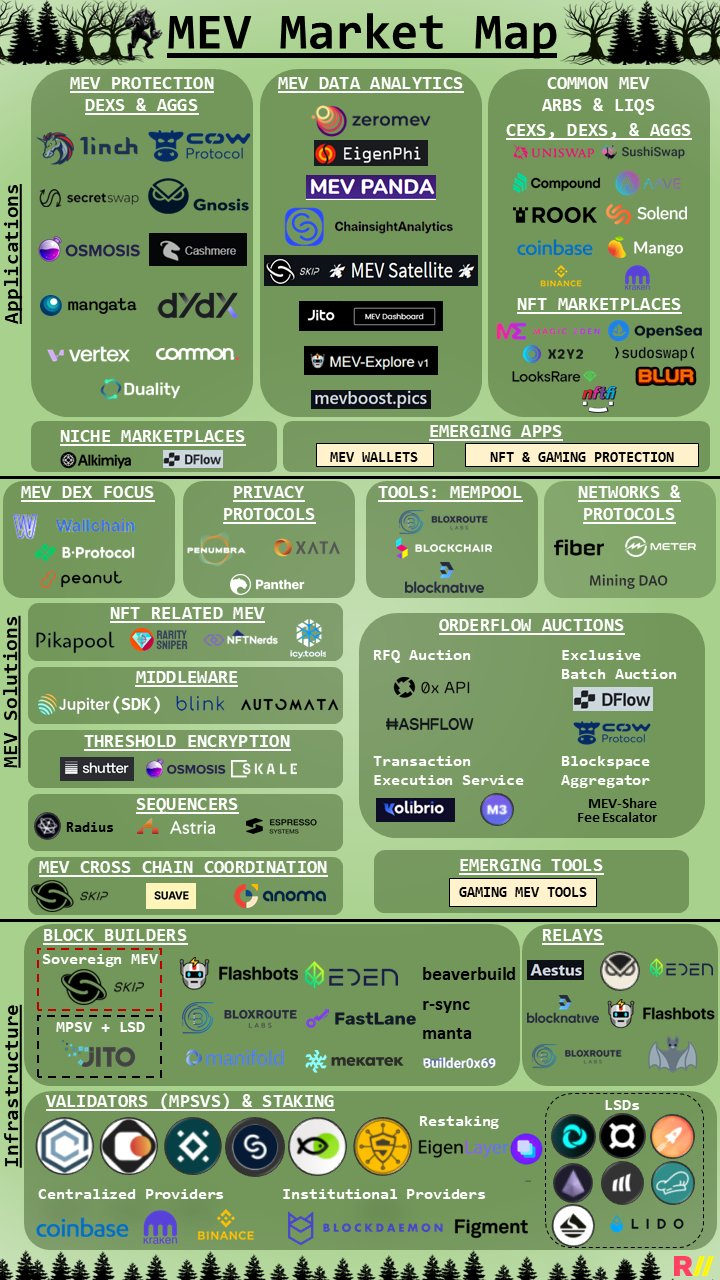Illustration of MEV All Tracks: How to Navigate the Dark Forest?
Original Title: 《Navigating the Dark Forest: Unraveling the Mysteries of the MEV Market Landscape》
Author: Ali
Translation: Deep Tide TechFlow
As blockchain technology continues to evolve, MEV has become a highly discussed topic. The MEV market is a complex and ever-changing field, and the classifications presented in this article may evolve over time. Nevertheless, researcher Ali provides a detailed map of the MEV market, exploring the complex world of MEV across three different categories:
Infrastructure;
Solutions;
Applications.

I. Infrastructure Layer
Starting from the infrastructure layer, this layer consists of "validators and staking participants." As anticipated in our earlier MEV research, the emergence of MPSV (MEV Profit Sharing Validators) has changed the market landscape, with many validators now offering enhanced MEV rewards alongside traditional staking yields. We observe the rise of MPSV and LSD in providing MEV rewards across different chains. Some notable validators offering MEV rewards to stakers include Cogent, Chainflow, Chorus One, and Stakefish.
Similarly, in the realm of LSD, many protocols are distributing MEV rewards among stakers, such as Manifold, Frax, Rocketpool, Laine (StakeWiz), Marinade Finance, and Lido. These market participants provide MEV rewards in addition to the returns from pure staking.
Above this subcategory, we find core block builders and relay participants. Block builders are highly specialized participants who construct blocks based on transaction order flows (public transactions, bundled transactions, private transactions, etc.). Relays accept blocks from builders and select the block that maximizes profit for the current proposer.
Within the block builder category, there are some unique participants, such as the Skip protocol (Cosmos), which provides sovereign MEV infrastructure. The term "sovereign" refers to Skip creating modular tools that allow application chains to fully control and customize transaction preference rules. Another participant is Jito, which acts as an MPSV and has its own liquid staking derivative, jSOL.
Each blockchain ecosystem typically has its own MEV block builder providers (Ethereum may have multiple providers). Some examples include: Skip / Cosmos, Jito / Solana, Flashbots / Ethereum, Fastlane / Polygon. From this analysis, two key insights emerge:
- We expect existing (or new) blockchain ecosystems to continue developing their unique block builder providers. Leaders may emerge within each chain, benefiting from increasing economies of scale.
- There is a clear demand for cross-chain MEV solutions, which should lead to collaborations with existing block builders to meet this demand.
II. MEV Solutions
MEV solutions encompass a range of tools and protocols designed to help extract, prevent, or popularize MEV across the ecosystem. One of the most notable subcategories in this section is cross-chain coordination of MEV led by leaders such as Skip Protocol, Suave, and Anoma. The growing popularity of cross-chain, composability, and modularity naturally paves the way for new types of cross-chain and interval MEV solutions.
Another interesting subcategory is the (shared) sequencer segment, which focuses on second-layer scaling solutions. Shared sequencers mitigate MEV-related risks by promoting fair and consistent transaction ordering, thereby limiting the opportunities for front-running transactions and bots to exploit profitable trades.
Other emerging areas include MEV solutions related to NFTs, such as Pikapool, which aims to create a specific NFT memory pool and reduce any negative externalities of MEV. Other NFT-focused tools include sniping and scarcity query tools that arbitrageurs can use to maximize profits and trade NFTs.
Finally, we believe a new category that is about to develop will be the game MEV tools market.
Blockchain games are interesting because they often involve DeFi (i.e., game tokens) as well as NFTs (i.e., game assets). As we see more innovations in the gaming space and the development of the crypto gaming industry, we believe the timing for MEV to enter is ripe. We have seen MEV enter DeFi, then NFTs, and considering that a major component of on-chain gaming is NFTs, it is natural for MEV to play a crucial role here, especially regarding user experience. Existing MEV participants will capture this market, or we may see some new entrants emerge.
Some early examples of long-tail game MEV include mgnr developing a free market to sell locked $JEWEL tokens from DeFi Kingdoms—this opens the door for various arbitrage opportunities for illiquid game tokens.
III. MEV Application Layer
The application layer includes end-user products that span the MEV ecosystem. On one hand, many DEXs and aggregators emphasize MEV prevention. On the other hand, other markets and trading platforms frequently encounter MEV arbitrage and liquidation.
Another interesting category we see is niche-specific markets for block space and order flow payments. Examples in this area include Alkimiya and DFLOW. It will be interesting to see how these markets are utilized and what new use cases emerge from them.
We predict that two important categories will emerge in this layer:
NFT and gaming markets that provide MEV protection. Instances of NFT MEV include bot activity during minting, arbitrage opportunities involving floor prices, or liquidations of NFT loans. In terms of prevention, we specifically refer to mitigating bot activity. As previously mentioned, the increasing popularity of on-chain gaming is likely to introduce various forms of MEV into the space. Therefore, gaming platforms must adjust their protocols to address these challenges.
MEV wallets. Wallets serve as a hub between users and decentralized applications, and we hope wallets will begin collaborating with MEV solution providers or block builders to help users recapture any MEV slippage they may encounter, or even new forms of MEV.
In summary, the MEV market map provides a comprehensive overview of the complex and dynamic world of MEV. As the market continues to evolve, we will remain committed to collaborating with the broader community to refine and update this resource. Together, we can navigate the "dark forest" of MEV and illuminate the path toward a more transparent, secure, and equitable blockchain ecosystem.








